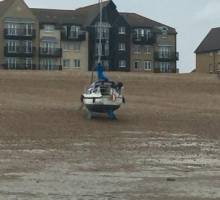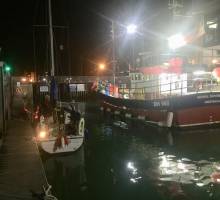
Boatshed Brighton's Intrepid Dan and Squeezebox's Beaching Adventure!
One of my favourite places to visit is St Valery sur Somme. It has a challenging approach requiring navigation between fifty buoys zig zagging in shallow water up a ten mile estuary to the town harbour. You have to get the arrival time just right to avoid running aground on the massive mud banks either side of the narrow channel. There is a pretty ferocious flood and ebb tide. The whole area is a renowned nature reserve.
So that was the intended destination as I set off with a friend at 4pm one sunny August afternoon in Squeezebox, my 1970 Westerly Pageant. A gentle breeze and a fair tide added to the joy of the
passage. The sun set, the wind dropped to zero and the sea was so smooth we could see the reflections of Mars, Jupiter and many stars in it.
We chugged along at a little under four knots in
order to reach the ATSO buoy at the Somme entrance at 9.30am the following morning. At 11.30pm our enjoyment was rudely interrupted by a big jolt followed by the engine stalling. A quick check over the transom failed to reveal any evidence of nets, flags or poles. We were bang in the middle of the Channel between the two traffic zones, some 27 miles from Sovereign Harbour and the ATSO buoy, drifting south west at about a knot. A call to Dover coastguard explaining that
we could not sail out of trouble led to a rescue by the Eastbourne offshore lifeboat, bless them.
A tow back to Sovereign Harbour at over twice our earlier speed ended at 5.30am. Some days later I heard that the lads had enjoyed the “shout”, flat out in smooth seas for once. After a cooked breakfast my friend went home. I loosened the mooring lines and gently worked my boat at tickover backwards and forwards on its mooring then radioed the marina to say I could limp back to my berth. It turned out a large cargo net had wrapped itself firmly around the prop.
The following day I decided to beach the Squeezebox near Fisherman’s Village at the eastern end of the Sovereign Harbour estate. The winds were light and high tide was 1.30pm. My crew member was on the beach making sure a 10 metre stretch was clear of fishermen, swimmers and any paddle boarders. Another friend suddenly turned up for the ride, it sounds like fun he said.
Squeezebox limped round the outer harbour breakwater with him on the tiller.
“What’s the form?” he asked. “As we approach the beach at right angles” I said “I will be at the bow ready to drop the anchor in four to six feet of water. You then reverse so I can pay out the line.” “OK” he replied. Seeing my other friend on the beach I signalled the helm to aim for a space between two groynes.
We seemed to get very close to the beach. “What’s our depth?” “4ft!” “I’m dropping the anchor now” I shouted. “This is just like the D day landings” he said as he drove onto the beach somewhat
higher up than I intended. The time was 2.30pm. As the tide receded the problem became apparent.
I had taken the precaution of bringing a large sharp knife and a ladder, I did not want to use the swim ladder. Squeezebox had beached horizontally, the front of the bilge keels had dug some inches
into the shingle. It only took about fifteen minutes to remove the net, which nearly filled a 10 lire bucket. My friends thoughtfully started scraping barnacles off the hull. The hot summer has made 2018 a vintage year for fouling.
After an hour my friends left and I carried on scraping off barnacles, filling nearly three buckets in all. The sight of a beached boat drew a lot of attention. One family came down offering hamburgers and
sausages from their barbecue outside the flats overlooking the beach. So nice, but I never set out without food and water no matter how short the trip. A young lad cane up and says “Looks like
you’ve got a problem mister!” He promptly got a lecture on the advantages of a bilge keeler.
Several other young children out with their parents asked to have a look inside the boat. As dusk fell Squeezebox looked totally stranded as the tide receded. I paid out 60ft of rope off the stern with a kedge anchor on the end and recovered and stowed the
bow anchor.
My crew friend returned and said he would stay for the trip back, which was good of him. Once on board I lifted and stowed the ladder at the bow. It seemed ages until the tide returned but by 10 pm waves were lapping under the keel. I explained to him that when I was sure the prop was underwater and the boat began to lift I would start the
engine and put it in reverse. I would then put it half forward and he was to immediately helm sharply to starboard. “Will we miss the breakwaters ?” he asked. “We have to!” was my reply.
A tense minute followed as the boat turned round and I frantically pulled in the kedge anchor…….the last thing I needed was another fouled propeller. I dumped the kedge and its rope unceremoniously
into the cockpit and relaxed as we headed out to sea.
The Royal Sovereign fishing boat appeared ahead of us aiming for the harbour. “Follow that boat!” I said. We rounded the buoys marking the wreck of the SS Barnhill outside the harbour and followed the Royal Sovereign into the lock. It was 11pm, a long but interesting day.
I resolved to repeat the beaching exercise mid season next year to clean the hull, much cheaper than a lift out. But I would aim for lower down the beach well away from the wooden groynes and save
several hours waiting for the tide to return.






